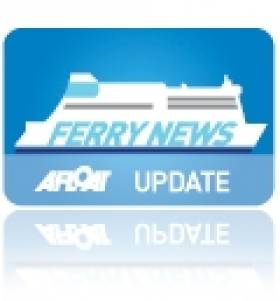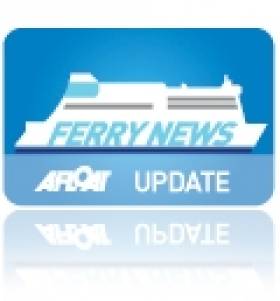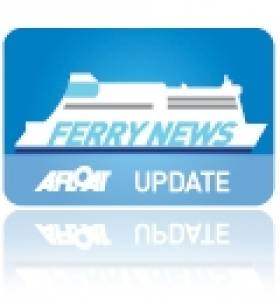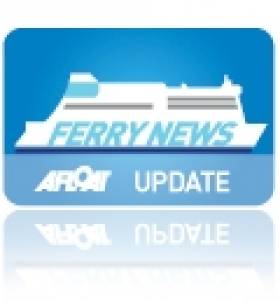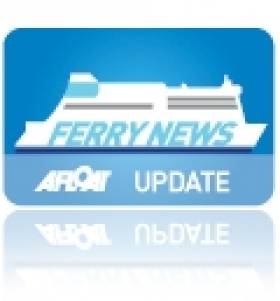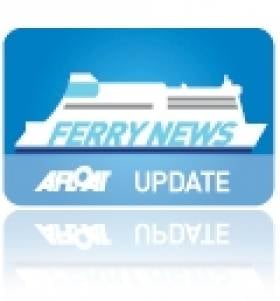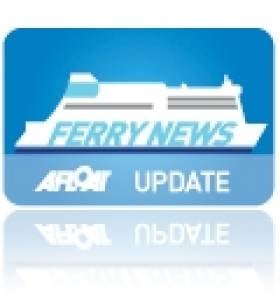Displaying items by tag: Celtic Horizon
Celtic Link Ferries to Go Cycling with Giro D’Italia
#CelticGiroDItalia – Celtic Link Ferries Italian flagged ro-pax Celtic Horizon will be carrying the cycling cavalcade for one of the world's greatest cycling events, the prestigious 2014 Giro D'Italia, which takes place next May with an all island staged route, writes Jehan Ashmore.
According to Wexford Chamber of Commerce, the ferry operator which runs between Rosslare-Cherbourg, recently transported a fleet of Volkswagon vehicles to see this year's Giro D'Italia in Naples.
The Giro D'Italia in 2014 will stage its 'Grande Partenza', the Big Start in Belfast and will visit Armagh and also Dublin between 10-12 May.
Hosting three-day event, which will be its 97th edition, will cost in the region of €5,000,000.
It is also estimated the event will generate to the value of €12m and which has the backing of Northern Irish Tourist Board (NITB) and Tourism Ireland.
"Celtic Link Ferries are delighted to be involved with this great event which will be the focus of the entirety of Europe" said Tourist Passenger Manager, Rory McCall.
"We are a perfect fit for something like this" added McCall. "Celtic Link Ferries will give intending passengers the best value means of travelling between Europe and Ireland with a vehicle".
Celtic Horizon which is registered in the Adriatic Sea port of Bari, has a total 2.25 kilometres of vehicle lane metres spread across its decks from where traffic is transported on the thrice weekly operated service.
Afloat.ie adds that Rosslare Europort is no stranger to such sport-related logistics, as the Tour de France made its first and only visit to Ireland in 1998.
On that occasion, ferries transported the cycling cavalcade from the Wexford port and also out of Cork to Roscoff.
Celtic Link Ferries Bring Visitors for St. Patrick's Gathering
#GatheringVoyage – As previously reported on Afloat.ie Celtic Link Ferries were proud to have transported over 400 passengers on board Celtic Horizon from mainland Europe to Ireland for St. Patrick's Day 2013.
The only ferry company which sails between Ireland and France (Cherbourg-Rosslare) all-year-long gave passengers a unique opportunity last weekend to sail with a vehicle, a cabin and occupants for only €1.
The special priced fare was tied to promote Ireland's year-round Gathering celebration and to encourage people to visit Ireland.
"There was a great atmosphere on board, people delighted with the great offer and getting to come home and see their loved ones" said Tourist Passenger Manager, Rory McCall.
"Celtic Link Ferries did their best to insure that people got to visit Ireland for St. Patrick's Day as comfortably as possible, as cheaply as possible."
McCall added "This will be the first of many offers trying to increase visitors to Ireland and more specifically to Wexford and the rest of the South-East".
"Celtic Link Ferries have been very fortunate to have the support of Rosslare Europort on this offer and look forward with working with them on more special offers for the rest of 2013."
Throughout 2013 Celtic Link Ferries will be offering competitive fares to insure that even more tourists visit Ireland on the thrice-weekly operated Cherbourg-Rosslare route.
The Gathering Looms Ever Closer as Celtic Horizon Heads for St. Patrick’s Festivities
#GatheringVoyage –Passengers today on board Celtic Horizon which is due to make a lunchtime arrival in Rosslare Harbour are taking advantage of a special celebratory 'Gathering' sailing, writes Jehan Ashmore.
As previously reported, Celtic Link Ferries had been promoting a €1 euro motorist fare on this particular crossing which departed Cherbourg yesterday in advance of St. Patrick's Day festivities held across the nation in this year of The Gathering.
In addition to Irish and continental passengers, there are representatives from the tourism sector travelling on this Gathering sailing.
As the Celtic Horizon heads towards the Tuskar Rock Lighthouse, there will no doubt be an on board atmosphere of excitement as the Emerald Isle looms increasingly closer.
Celtic Horizon is the newest and fastest vessel operating on the French-Irish route and among the facilities are the aptly named Tuskar Lounge, Rosslare Bar and Cherbourg Café.
Rosslare Ferries Past and Present Profiles
#FERRY FOCUS – Two Rosslare Europort ferries, past and present are profiled in the latest issue of Ships Monthly. Normandy having served a near decade long career with Irish Ferries and Celtic Horizon as previously reported on Afloat.ie which has only been in service since late 2011 serving Celtic Link Ferries.
The former Normandy, a month ago today was beached at Alang, India to undergo scrapping, following failed plans by Singapore owners to convert her to an offshore accommodation vessel for the energy industry.
She had served several routes throughout Northern Europe since her completion in 1982 as Prinsessan Birgitta for her original owners Sessan Line, before becoming part of Stena Line and at one stage she became 'Sealink's flagship St.Nicholas.
Incidentally during Normandy's career until 2007, her younger sister launched as Kronprinsessan Victoria, now named Stena Europe, was by sheer coincidence sailing out of Rosslare and still remains on Stena Line's route serving Fishguard.
Normandy was the first of the Irish Ferries fleet to change flag, where the Irish tricolour was replaced under the Bahamas flag. This initially led to strike action by UK, French and Irish unions that led to a longer-running hostile dispute during 2005/2006 by Irish seafarers whose jobs were ultimately replaced through outsourcing of lower paid agency crews mostly from Eastern Europe.
Eventually the remaining Irish Ferries vessels, flagship Ulysses, cruiseferry Isle of Inishmore and fast-ferry Jonathan Swift also changed flags, but to Cyprus and with a change of port registry to Limassol.
As for Celtic Horizon she is on a charter contract to Celtic Link Ferries Rosslare-Cherbourg service, the 2006-built ro-pax having served Naples-Sicilian routes for Caronte & Tourist.
The introduction of Celtic Horizon brings increased space and higher standard passenger facilities compared to her predecessor Norman Voyager, which too was delivered from the same Italian shipbuilder Visentini near Venice.
At this time of the year CLF are the only operator providing Irish-French sailings until Irish Ferries re-launch cruiseferry Oscar Wilde sailings for their 2013 season starting in late February, initially to Cherbourg followed in May by additional high-season sailings to Roscoff.
French Ferry Sailings Set to Resume Service
#FERRY TO RESUME – Services on Celtic Link Ferries Rosslare-Cherbourg route as previously reported on Afloat.ie are scheduled to resume with tomorrow (20 November) night's sailing departing 21.30hrs.
According to the ferry operator, the ro-pax ferry Celtic Horizon will be operating to a reduced capacity, however the sailing will mark the return of standard sailing times.
Due to the restrictions in place any passenger with special needs are requested to contact CLF on 053 916 2688 (Ireland) or 02 33 43 23 87 (France) and for further information visit www.celticlinkferries.com
No Ferry Sailing due to Mooring Issue in Cherbourg
#NO FERRY SAILING – Due to a mooring issue that took place in Cherbourg, there will be no sailing today (18 November) on Celtic Link Ferries 19.00hr departure from Cherbourg to Rosslare.
According to the operator's website, yesterday's outward sailing from Rosslare was also cancelled and that passengers intending to travel today will also be looked after on other sailings. In the meantime the ro-pax vessel remains berthed at Rosslare Europort.
To keep updated of further developments passengers are requested to consult the operators website HERE and by contacting CLF on 053 916 2688 (Ireland) or 02 33 43 23 87 (France).
A Year on the Horizon for Celtic Link's Ro-Pax Ferry
#CELTIC LINK - The Celtic Horizon, the 27,522 tonnes ro-pax ferry this week celebrates her first year in service on Celtic Link Ferries Rosslare-Cherbourg route, writes Jehan Ashmore.
According to the Celtic Link they have had a 'resoundingly successful inaugural year with the Celtic Horizon'. The Co. Wexford based operator saw double digit-growth in the number of tourist passengers sailing on the 17 hour route.
Celtic Link envisage that this growth will continue in 2013 and as the only year-round operator between Ireland and France. On the freight front, strong performance has been recorded despite the turbulent economic conditions in which the company has claimed to have performed in line with yearly forecasts.
The 1000 passenger capacity ferry, with space for 200 cars and up to 120 freight vehicles, completed her first round trip voyage last October, having been chartered by CLF for a five-year term contract. On board the 186m vessel facilities include 110 cabins, a bar, restaurant, lounges, cinema, shop and wi-fi connectivity.
Celtic Horizon was built in 2006 by Cantiere Navala Visentini, Portoviro, in Italy and she retains her port registry of Bari. As the Cartour Beta, she began her career serving routes between Naples and Sicily for Caronte & Tourist (C&T) until her charter ceased late last summer.
Last September, the vessel was berthed in Palermo, in advance of her four-day delivery voyage to Ireland. The voyage set a course that saw her offshore of the Algerian coast and before leaving the Mediterranean, an en-route call was made to Gibraltar to load bunkers, until she finally reached Rosslare Harbour.
She has more passenger deck space compared to her predecessor, Norman Voyager, which likewise was built of the same overall ro-pax design of the Italian shipbuilder. A notable and novel feature is the escalator which whisks passengers from the vehicle decks to the main passenger deck.
A Celtic Link Voyage to The Gathering 2013
#FERRY NEWS – Celtic Link Ferries are to participant in Ireland's The Gathering 2013, a year-long initiative to celebrate all things Irish, with a unique opportunity to take a car from France on their Cherbourg-Rosslare service for free, writes Jehan Ashmore.
The special offer is limited to the sailing scheduled to depart Cherbourg on 15th March, with an arrival the next day to Rosslare Europort, in advance of the nation's annual celebrations on St. Patrick's Day.
Those travelling on this sailing will have the chance to sample the Celtic Horizon, the newest and fastest ship sailing on this route between Normandy and Wexford.
Among the facilities on board the 27,522 tonnes vessel is the forward facing restaurant, the Cherbourg Café Lounge and adjoining children's playroom, cinema and Wi-Fi. Accommodation is provided in 110 cabins and vehicle decks for 200 cars and up to 120 freight trucks.
For further details of The Gathering voyage and other offers visit: www.celticlinkferries.com
Inaugural High-Season for Celtic Link Ferries Newcomer
#CELTIC LINK – Rosslare-Cherbourg operator Celtic Link Ferries which runs the Celtic Horizon (2006/27,522grt) on the 17 hour route, is operating her first high-season, since the 940-passenger ship was introduced last October, writes Jehan Ashmore.
Celtic Link Ferries are the only company to provide an all year-round service on the Irish-French services which are also served by other operators running out of Rosslare and Cork.
The Celtic Horizon has larger and improved passenger facilities compared to predecessor Norman Voyager. Among the facilities on board the newcomer is the forward facing restaurant, the Cherbourg Café Lounge and adjoining children's playroom, cinema and Wi-Fi. Accommodation is provided in 110 cabins and vehicle decks for 200 cars and up to 120 freight trucks.
CLF have a short wine-break offer for a driver and companion, plus return car to stock up on your favourite French wines. The offer also includes a two berth outside cabin both ways and costs €200. For further, information click HERE.
Celtic Horizon Officially Enters Service
She replaces the Norman Voyager which too was built by Visentini. The 186m ro-pax vessel last week arrived from the Mediterranean (to read more click HERE) and will be chartered to CLF for a five-year term contract. Overall she has a larger passenger deck compared to her predecessor, with a restaurant, two bars, pull-man lounges, a cinema, children's play-area, game-zone and kiosk-shop.
In addition to her 130 cabins she has five vehicle decks for 200 cars and a total 2,500 lane freight metres equating to around 110-trucks. An unusual feature is an escalator that whisks passengers from the car-decks up to the passenger deck.
Prior to the event, Celtic Horizon had arrived into the Wexford port. She had completed her maiden 'Irish' round-trip commercial voyage over the weekend from Cherbourg during stormy seas under the command of Captain Richard Collins.
Last year CLF handled 60,000 passengers and 50,000 vehicles between tourist vehicles and freight business. This year they are expecting an increase of passenger traffic of around 30%. The company are the only ferry operator running year-round sailings on the Irish –French routes.
CLF took over the Rosslare-Cherbourg route from P&O in 2005. With the Celtic Horizon they will continue providing three-round trips per week on the route which transports passengers, tourist cars, camper-vans, freight trucks including livestock and the importation of French manufactured new trade-cars.


























